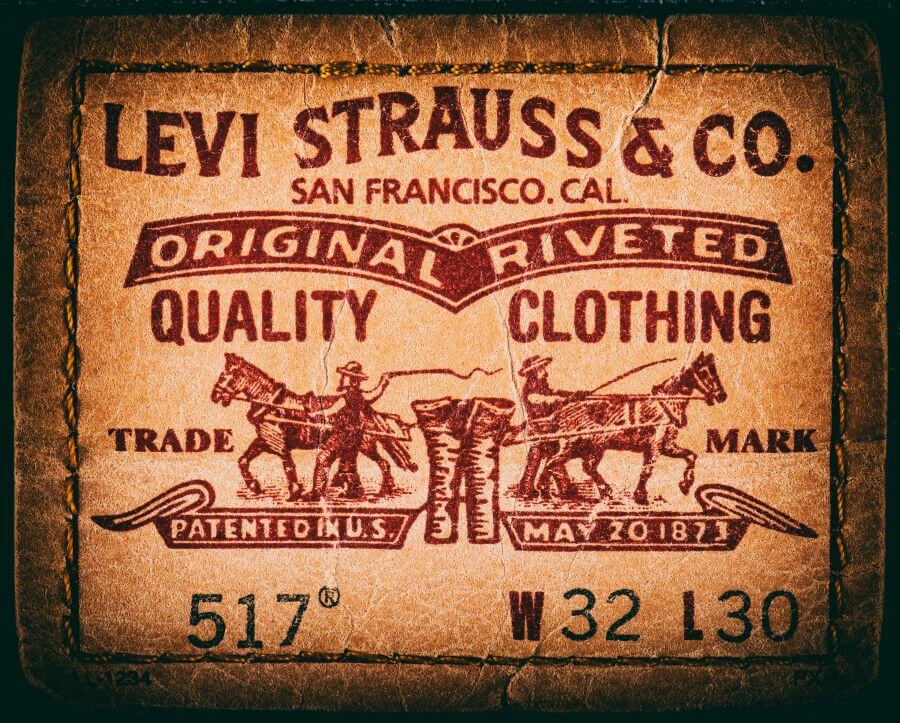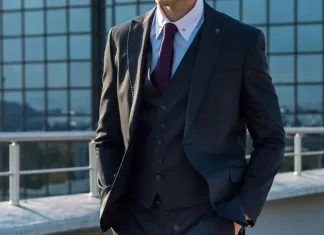
First Published: 24th August 2023, written by Ciaran Clarke | Last Updated on 24th January 2024 | Reviewed and Edited by Chloe Safilo
Every item of apparel you own or see has some sort of clothing branding identifier, even if it’s an inside label at the back of the t-shirt neckline, or waistband of your jeans. Every garment will have important wash care information, sizing, and some manufacturer’s identifying code. It will also have the brand name of the clothing company that sold the attire.
Seeking out skilled tailors and seamstresses has probably been around as long as clothing was the latest trend of sabre tooth tiger fur. And not doubt over history some marked or initialled their work, but this is not the same as branding for marketing reasons.
The 19th Century godfather of haute couture, Englishman Charles Frederick Worth, is credited as the first fashion designer to have his label sewn into the garments he created. Producing the first ready to wear clothing in 1858, he wanted consumers to be able to identify the product being produced by his Parisian House of Worth. And the Europeans loved to boast and flex about their new expensive clothing that was all the rage in Paris.
It’s difficult to find actual evidence of the first fashion brand to outwardly promote it’s label as branding to increase demand, but it’s origins will always be found in workwear. Workers wore branded clothing to signified where they worked, but of course armies have worn a uniform for identification purposes for centuries so
But as actual evidence goes, Levi Strauss jeans deserve the accolade with their external branding on the branded copper rivets (1876) and outer leather patch on the jeans as far back as 1886. And they claim that illiterate ranchers would walk into stores asking for the jeans with the two horses, so it clearly worked as early marketing too.

As for visual logo’s, you could argue Frenchman Rene Lacoste wearing tennis shirts with a crocodile logo embroidered on the chest. While he had first designed them in 1926 (basically polo shirts rather than the long sleeved shirts tennis players wore at the time), the large logo was proudly promoting a nickname given to the egotistical Frenchman by the American press in 1927.
This is first documented visual branding although wasn’t on commercial sale a the time. But Lacoste set up the La Chemise Lacoste clothing brand when he retired in 1933 to sell reproductions of the shirt. Potentially this is the first case of famous sportsman turned fashion brand owner, it depends if you consider Spalding which is arguably sports equipment. For the record, Chuck Taylor only worked for Converse as a salesman.
Just as a side note on Lacoste, Izod purchased license rights in the USA and after initial limited interest got his famous friends such as JFK, President Eisenhower and Bing Crosby to wear them. Unsurprisingly, this celebrity endorsement influenced the American public to buy the brand. If you consider that in 1950 only 9% of American households had a television set, but by 1960 this had reached 90%, it was likely was the first case of influencing too.
Other famous brands in the late 1950’s were experimenting with external branding, like Coco Chanel’s intertwined CC logo on the jacket buttons. And in the 1960’s fashion individuality spread with screen printing designs for expression and group identities like the Punk movement.
But for me, big brand logo’s really took off in the 1980’s as MTV made people materially orientated and the masses more fashion conscious. An ordinary t-shirt could be transformed with a simply Swoosh logo, with the brand fashionable and not the clothes. This applied to footwear like Nike Air Jordan’s, Tommy Hilfiger jeans, to Calvin Klein boxer shorts, all made more desirable by TV adverts, billboards and print media campaigns..
Famous fashion logos
It’s fair to say, that with typographic logo’s it’s more a question of how famous a brand name is. But the key fashion brand logo’s are instantly recognizable worldwide. Want proof? Try our quiz below:
Results
First Published: 24th August 2023, written by Ciaran Clarke | Last Updated on 24th January 2024 | Reviewed and Edited by Chloe Safilo
First Published: 24th August 2023, written by Ciaran Clarke | Last Updated on 24th January 2024 | Reviewed and Edited by Chloe Safilo
#1. Which logo is Coco Chanel?
#2. Which emblem belongs to Fred Perry?
#3. Which logo is used by Fendi?
#4. Which is the Burberry motif?
#5. What is the logo for Rolex?
#6. Which logo is the classic Reebok?
Why do brands use visual branding on clothes?
Visual branding taps into the swagger and the common human desire to be better than our peers. It helps the wearer show the world they have money and buy expensive clothes. And this plays into the brands hands, as it’s free advertising that builds brand loyalty and recall.
Of course there is a noticeable shift into quiet luxury with minimal branding, but consumers still want people to know they are wearing high quality designer clothing.
Why do consumers buy designer brands?
Designer brands often:
- Have a reputation for using high-quality materials and superior craftsmanship.
- Associated with luxury, exclusivity, and social status. Consumers may buy these brands to signal their wealth, taste, and status to others. Owning and displaying designer products can be seen as a symbol of success and affluence.
- Known for their unique and innovative designs. Consumers may be drawn to the creativity and beauty of these products, appreciating the attention to detail and the sense of style they offer. Designer brands often set trends and influence fashion, making consumers feel fashionable and up-to-date.
- Develop consumer loyalty due to positive past experiences, trust in the brand’s reputation, or emotional connections. These consumers may continue purchasing designer brands because they feel confident in the brand’s ability to consistently meet their expectations and deliver a certain level of quality.
- Offer a high-quality customer service and shopping experience to their clients. Consumers may be willing to pay a premium for the enhanced customer experience they receive when purchasing designer brands.
- Are viewed as an investment. Certain luxury items, particularly those from iconic or limited-edition collections, can appreciate in value over time. Consumers may purchase these items with the intention of reselling them later at a higher price, or as a way to preserve and pass on a valuable asset.

What makes a good fashion logo?
There are several factors that contribute to making a good fashion logo:
1. Simplicity: A good fashion logo should be simple and easily recognizable. It should have a clean design that can be easily reproduced in various sizes and formats.
2. Unique and Memorable: A successful fashion logo should be distinctive and memorable. It should stand out from competitors and leave a lasting impression on customers.
3. Reflect Brand Identity: A good fashion logo should accurately represent the brand’s identity, values, and aesthetic. It should convey the brand’s personality and target audience.
4. Versatility: A well-designed fashion logo should be versatile and adaptable to various applications. It should look equally appealing on different mediums, such as clothing tags, websites, packaging, and social media profiles.
5. Timelessness: Fashion trends come and go, but a good fashion logo should have a timeless quality that can withstand changing trends. It should have the potential to remain relevant and recognizable for years to come. A good example is a flower logo, which is rarely utilised in fashion.
6. Colour and Typography: The choice of colour and typography in a fashion logo plays a crucial role in creating the desired visual impact. Colours should complement the brand’s identity and evoke the desired emotions, while typography should be legible and appropriate for the brand’s image.
7. Scalability: A good fashion logo should be scalable without losing its clarity and impact. It should look equally impressive whether it’s displayed on a large billboard or a small clothing tag.
8. Consistency: A strong fashion logo should be consistent with the overall brand identity. It should align with the brand’s other visual elements, such as packaging, website design, and advertisements, creating a cohesive and unified brand image.
9. Market Research and Testing: Before finalizing a fashion logo, it is essential to conduct market research and gather feedback from the target audience. This helps to ensure that the logo resonates with customers and effectively communicates the brand’s message.
10. Uniqueness: Lastly, a good fashion logo should be unique and avoid any resemblance to other well-known logos. It should be distinct and instantly recognizable as belonging to a specific brand.

















































